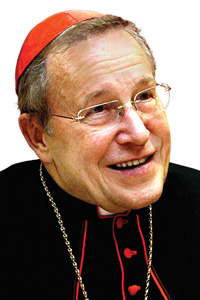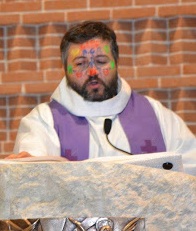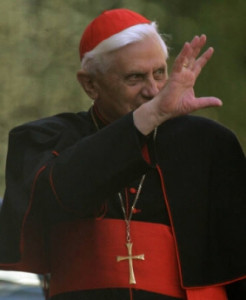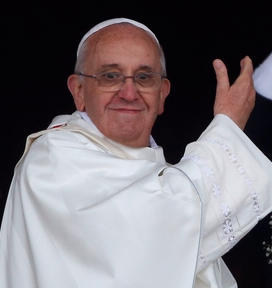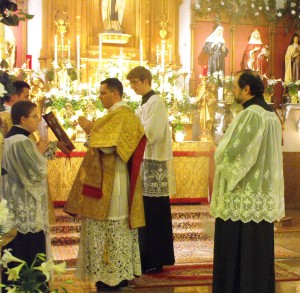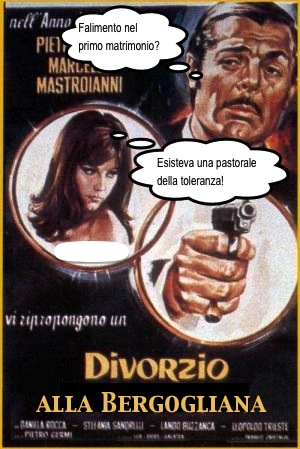 Francis applauds “profound theology” that blesses adultery.
Francis applauds “profound theology” that blesses adultery.
by Rev. Anthony Cekada
JUST ABOUT anyone who claims to be a Catholic can tell you that the Church teaches that divorce and remarriage are forbidden. He might even be able to tell you that the teaching is not just a “Church” law, but one that comes from Our Lord Himself: “Whom God hath joined together, let no man put asunder.” And he might even add that if you remarry while your first spouse is alive, you commit adultery.
Until now that is. For as we predicted last year, Bergoglio (“Pope Francis”) is pressing forward with his program to dismantle Catholic teaching on giving the Eucharist to the divorced and remarried, one of the six key points of Bergoglio’s revolution. For some reason Bergoglio believes that implementing this change will lure hordes of disaffected nominal Catholics back to the emptied and emptying churches of Europe and South America.
Since the traditional teaching is so deeply rooted not only in Catholic dogmatic and moral teaching, but also (despite Vatican II) in the consciousness of many Catholics, it was necessary to engage in extensive preparation for such a seismic shift. The biggest step came recently with Cardinal Walter Kasper’s keynote address to a meeting of all the cardinals in Rome on February 20-21, a gathering intended to prepare for the October Bishops’ Synod, which will have the family as its theme. Bergoglio’s personal choice of Kasper as keynote speaker for this topic was considered very significant. The cardinal has a reputation for being one of the more “liberal” modernists in the once-Sacred College.
The text of Kasper’s address to the cardinals was not supposed to be made public, but it was leaked to the Italian paper Il Foglio, which printed it in full. (It has yet to appear in English.) On February 21, at the end of the consistory, Bergoglio lavishly praised the speech:
Yesterday, … I read or rather re-read the work of Cardinal Kasper, and I would like to thank him because I found profound theology, and even serene thinking in theology. It is pleasant to read serene theology. And I also found what Saint Ignatius told us about, that sensus Ecclesiae, love for Mother Church. It did me good and an idea came to me — excuse me, Eminence, if I embarrass you — but the idea is that this is called “doing theology on one’s knees.” Thank you. Thank you.
Vatican commentator Sandro Magister says that Kaspar’s proposals represent nothing less than “a paradigm shift” on the issue — a complete change of context or perspective — and that it enunciates the program that Bergoglio intends to implement.
So what is Bergoglio’s program for the question of giving the Eucharist to the divorced and remarried, and what are the problems with it?
I. Kasper’s “Serene Theology”
The speech begins with a lengthy introduction, followed by four sections on the family in the order of creation, the “structure of sin” in family life, the family in the Christian order of redemption and the family as “domestic church.” This consists of several thousand words of convoluted modernist piffle which few in the Novus Ordo church will bother to read.
The fifth section, however, contains the real point of the speech: to provide Bergoglio and the “left” of the post-Vatican II hierarchy with a theological fig leaf for giving the Eucharist to the divorced and remarried. Here is Kasper’s warm-up before he gets to the nitty-gritty of practical proposals:
- The situation of divorced and civilly remarried Catholics poses a thorny problem.
- We can’t just consider it from a sacramental and institutional perspective. We have to “change the paradigm” and consider it from the point of view of those who “suffer.”
- Priests have to strive to reconcile the parties when marriages are in crisis. [Brilliant, Your Eminence! Brilliant!] They shouldn’t cease doing so “after the failure of a marriage.” [Wow!]
- After the “bitter experience of the past” with a Catholic marriage that ended in divorce, civil marriage and the new “relationship” can seem “like a gift from heaven.”
- What should the Church do? “[The Church] cannot propose a different or a contrary solution to the words of Jesus…. The indissolubility of sacramental marriage and the impossibility of a new marriage during the lifetime of the other partner is part of the tradition of the Church’s binding faith that cannot be abandoned or undone by appealing to a superficial understanding of cheapened mercy.”
- But now in the modern age, we face a “new situation” [of course!]. While formerly church law imposed the penalties for bigamy on those civilly married, including excommunication, these are gone. They are now invited to participate in the life of the Church. “This is a new tone.”
- Why not apply to their situation the same strategy Vatican II did with religious liberty and ecumenism? Sure, encyclicals and decrees of the Holy See “seemed to preclude other ways. Without violating the binding dogmatic tradition, the Council opened doors. We can ask ourselves: is it not perhaps possible that there could be further developments on the present question as well?”
Although he doesn’t say it, Kasper’s real aim is to allow the parties in the invalid second marriage to engage in marital relations with each other. Since the spouse from the first sacramental marriage is still alive, he must find a way to excuse them from adultery, either by claiming the first marriage didn’t really exist (was invalid) or by justifying adulterous marital relations on some other grounds. Kaspar proposes two possible solutions along these lines, both of which are “already mentioned in official documents.”
1. Let Parish Clergy Annul Marriages. This would, in effect, ditch the whole system of church marriage tribunals, and allow a member of the local clergy to decide whether or not a first marriage was valid.
- “Some of the divorced and remarried are in conscience subjectively convinced that their irreparably broken previous marriage was never valid.” In many cases their local priest is also convinced of this.
- Evaluating the validity of marriages was left to church tribunals, but this isn’t a matter of divine law and can be changed to a more “spiritual and pastoral” procedure.
- Perhaps a priest with “spiritual and pastoral experience” designated by the bishop could decide the validity of the marriage.
- This would be in line with Pope Francis’ January 24, 2014 speech to the Roman Rota (supreme marriage tribunal) in which he said “the juridical dimension and pastoral dimension [of resolving marriage cases] are not in opposition… Pastoral care and mercy are not opposed to justice, but they are so to speak the supreme justice, because behind each appeal they discern not only a case to be examined through the lens of general regulations but a human person who, as such, can never represent a case and always has a unique dignity.”
- The different levels of higher appeal in the marriage tribunal system cannot effectively decide “the good and the bad of persons” on the basis of “paperwork… without knowing the person and his situation.”
The consequences of the foregoing we will discuss below. However, merely expanding the procedure for annulling marriages this way, the cardinal says, is not enough. “This would create the dangerous impression that the Church is proceeding in a dishonest manner in granting what in reality are divorces.” Hmm. With the divorced and remarried one could also therefore allow…
2. “Penitential” Second Marriages. Kaspar’s argument runs thus:
- In 1994 and 2012, Ratzinger said that “that the divorced and remarried cannot receive sacramental communion but can receive spiritual communion.” This reflects “true openness.”
- “But it also brings up a number of questions. In fact, someone who receives spiritual communion is one with Jesus Christ. [. . .] Why, then, can he not also receive sacramental communion?”
- The answer was: Out of concern for “the sanctity of the sacrament.”
- “The question that is posed in response is: is it not perhaps an exploitation of the person who is suffering and asking for help if we make him a sign and a warning for others? Are we going to let him die of hunger sacramentally in order that others may live?”
- “The early Church gives us an indication that can serve as a means of escape from the dilemma.”
- The basis is an article Joseph Ratzinger wrote in 1972: “In the individual local Churches there existed the customary law on the basis of which Christians who, although their first partner was still alive, were living in a second relationship, after a time of penance had available [. . .] not a second marriage, but rather through participation in communion a table of salvation. [. . .]”
- This would be “the way of conversion.” It would apply to a divorced and remarried person who (1) repents of his failure in the first marriage, (2) “clarified its obligations,” (3) can’t avoid abandoning the civil marriage “without further harm,” (4) does his best to “live out the possibilities” of the second marriage, and (5) has the desire for the sacraments, after a “conversion” or “a period of time in a new direction.”
- It would “not be a general solution.”
- “Should we not take into account the fact that we will also lose the next generation and perhaps the one after it too? Our long-established practice, is it not showing itself to be counterproductive?”
- The foregoing was the practice of “the early Church,” according to the studies of Cereti (1977) and Crouzel/Ratzinger (1972).
- “There can be no doubt however about the fact that in the early Church, in many local Churches, by customary law there was, after a time of repentance, the practice of pastoral tolerance, of clemency and indulgence.”
- This is proven by reference to the Council of Nicea (against the rigorism of Novatian), Origen, Basil the Great and Gregory Nazianzen.
- “J. Ratzinger suggested that Basil’s position should be taken up again in a new way. It would seem to be an appropriate solution, one that is also at the basis of these reflections of mine…. In the changed current situation we can however recover the basic concepts and seek to realize them in the present, in the manner that is just and fair in the light of the Gospel.”
And for those who find Kasper’s proposals appalling and who still long for the days of the Rottweiler of Orthodoxy, let us note in passing here that the cardinal bases his arguments on the work of Ratzinger himself.
II. Analysis and Consequences
Even to many souls with only a limited understanding of the traditional Catholic doctrine on divorce and remarriage, Kasper ideas will seem extremely fishy: You’re “subjectively convinced” that your first Church marriage was invalid, and all you need is a priest’s say-so before marrying again? Spiritual communion is equivalent to sacramental communion? Receiving communion while still in an adulterous relationship is OK? The early Church permitted this?
But Kasper’s address will have enormous consequences, so we must look at it a bit more closely. And to aid us in our analysis, we are very fortunate to have Professor Roberto de Mattei’s extensive critique, also published in Il Foglio, and then promptly posted in an English translation on Rorate Caeli.
1. A Slap in the Face to the Virtuous and the Suffering. In my priestly life, I have known many men and women whose marriages in the Church ended in bitter conflict and civil divorce, but who despite tears, suffering and human loneliness, remained resolutely faithful to the vows they had pronounced before God, even though their spouses did not. They knew what their obligations were and made every effort to sanctify themselves in order to live up to God’s law. I have also known Catholic couples who contracted an invalid second marriage from which they could not depart due to children, old age or poverty, but who, in order to return to the sacraments, vowed before God to live henceforth as brother and sister. Kasper’s proposals are a slap in the face to souls like these who struggled mightily and long to observe the divine law whatever the cost, and who, unlike the cardinal and his master, Bergoglio, took God’s law seriously enough to suffer for it.
2. “Pastoral” Camouflage for Overthrowing Dogma. In a post late last year, we pointed out that in his public discourses Bergoglio repeatedly employs the term “pastoral,” a ’60s modernist code word. After discussing how the term was applied to bishops in the post-Vatican II era and after summing up Professor de Mattei’s analysis of how Francis uses it in his public pronouncements, we concluded that
The key to decoding what Bergoglio and other modernists like him mean by “pastoral” [is that] through actions, silence or dissimulation one seeks to undermine Catholic dogma and morality by changing men’s experience of them.
This is exactly the dynamic at work in Kaspar’s speech. He pays lip service to the traditional Catholic teaching, saying we cannot undo it by “appealing to a superficial understanding of cheapened mercy.” And guess what? He then proposes practices which offer exactly that — “cheap mercy” purchased at bargain basement prices without true repentance for sin and without a firm purpose of amendment. When it comes to the first, valid marriage, the dogmas of the unity and indissolubility of the marriage bond are ignored, because you are free to continue the adulterous marital relations of the second invalid marriage.
In practice, the dogmas no longer exist, because Bergoglio and Kasper have come up with a “pastoral” workaround that renders them moot. De Mattei latches onto the connection Kaspar makes between his proposals on marriage and Vatican II’s “opening of the doors.”
Opened the doors to what? To the systematic violation, on the level of praxis, of that dogmatic tradition where the words affirm it legally binding.
3. No Mention of Sin. “Cheap mercy” of the sort Kasper and Bergoglio envision, moreover, becomes possible because, as de Mattei says, “the word sin does not enter into Cardinal Kasper’s vocabulary and never appears in his report to the Consistory.” This is probably because anything more than a generic notion of sin (against the environment, against “the poor,” against “the immigrants,” etc., as opposed to particular sinful acts by an individual) is considered “negative” theology in the modernist system. Moreover, “Cardinal Kasper does not express even one word of condemnation on divorce and its disastrous consequences in western society.” This in turn allows him to use the weaselly expression…
 4. “Failed Marriages.” Here, after reading Kaspar, one is left with the impression that impersonal objects called “marriages” are constantly floating around, and that when they somehow undergo enough stress fractures from causes unknown, they fly apart on their own, damaging the husband and the wife who happen to be nearby. “Marriage failure” is something like getting cancer. Stuff happens, marriages explode, etc.
4. “Failed Marriages.” Here, after reading Kaspar, one is left with the impression that impersonal objects called “marriages” are constantly floating around, and that when they somehow undergo enough stress fractures from causes unknown, they fly apart on their own, damaging the husband and the wife who happen to be nearby. “Marriage failure” is something like getting cancer. Stuff happens, marriages explode, etc.
The notion constantly pops up in Bergoglian discourse. Here is Francis talking about marriage on Feb. 28, just a few days after the appalling Kasper speech:
When this love fails — because many times it fails — we must feel the pain of the failure and accompany those who have failed in their love. Not condemn them! Walk alongside them.
The love-fails/marriage-fails formulation intentionally sidesteps the issue of the moral responsibilities of the respective spouses in a marriage that breaks up. The husband fails, the wife fails, or they both fail. By this we mean that one or both do not live up to the moral responsibilities of their state of life, commit sins, and as a result, destroy a grace-filled union that is blessed by God. The husband, the wife or both, drink, fight, commit adultery, show contempt for the spouse, scandalize the children, pout, seek revenge, lie, abandon the other, take drugs, use porn, contracept, undermine the other’s authority, spend money recklessly, are miserly, talk endlessly at the other, refuse to communicate at all, disappear, control every aspect of the spouse’s life, show no interest in the spouse’s life, or intentionally wound the other. In any break-up, at least one of the spouses has not tried to overcome his sins and faults, and to live up to the duties of his vocation by cooperating with the graces of the sacrament he has received.
This is not to say that one or both spouses cannot repent of the habitual sins that ultimately led to their separation, and achieve sanctity thereafter. But Kasper’s formulation, abstracted from any clear notion of individual sin and moral responsibility for the divorce, conceals the reality that the illicit second relationship — far from being what Kasper calls “a gift from heaven” — is the consequence of sin in the first marriage.
5. Drive-Thru Annulments. The Church established an elaborate system of ecclesiastical tribunals and a whole body of procedural and substantive law to protect the sanctity of the sacrament of marriage. It was difficult to obtain an annulment before Vatican II precisely because the grounds for declaring a marriage contract null were very few (e.g. force, grave fear, error) and the system was weighted against deception or self-serving claims by the parties. Even though annulments were granted on spurious grounds after Vatican II and handed out like candy, the fiction of a legal system that protected the sanctity of matrimony was at least maintained.
This fiction may disappear. Kasper says that since some of the divorced and remarried are “subjectively convinced” that their first marriage in the Church was invalid, and that the clergy involved in their care often agree with them, let a priest with “spiritual and pastoral [that word again!] experience” decide the issue. Maybe a confessor or the bishop’s vicar for the area.
This is the ’60s “internal forum” solution followed by modernist clergy of the era, but writ large and officially canonized.
Poof, no need for all those tribunals! Father Chuck can decide! And what do you think Fr. Chuck will decide if you walk into his office or confessional, say you were really immature when you got married, did not understand its “covenant” aspect, felt pressured because you were living together, didn’t really know what love was, just wanted to make mommy and daddy happy, and cry Fr. Chuck a river? Poor boy, poor girl, you didn’t really intend to get married, did you? I’m sure you’re in perfectly good conscience. And didn’t good Pope Francis say we should be merciful? So repent of that bad, old, first “failed marriage,” do penance for it (a decade of the Rosary if you remember how, or alms to Greenpeace if you don’t), feel free henceforth to approach extraordinary minister Ms. Gauleiter for the Eucharist, and now go in peace to love and serve the Lord.
If this procedure were allowed, says Professor de Mattei, “it is easy to imagine how the annulment of marriages would spread, introducing de facto Catholic divorce, if not by law, and incurring devastating damage to the human good.”
6. An Invitation to Derision and Scandal. As for the foregoing proposal, as we noted above, even Kaspar himself says it “would create the dangerous impression that the Church is proceeding in a dishonest manner in granting what in reality are divorces.” The impression of dishonesty? The impression of divorce? It would create the REALITY of both.
Any Protestant, any non-believer, who had an ounce of sense would say that the Catholic Church has changed its teaching and now permits divorce and second marriages. To dress the procedure up as an “annulment” — as if a real marriage never existed in the first place — is to invite mockery and accusations of utter dishonesty, even (according to a recent poll of Austrian and German Catholics) from people who would supposedly benefit from it:
But reforming and streamlining the church’s annulment process would not make a big difference in Germany, the bishops’ report said, because most remarried people do not regard their original unions as “null and void,” but rather as having failed. “They therefore frequently consider an annulment procedure” — which declares that an apparent marriage was null from the start —”to be dishonest.”
7. Make It a Six-Pack? The change would also be a source of scandal in countries where polygamy is rife, as even some African bishops recently said. Those who join the Church must choose one wife and leave the rest. If the Church can permit Westerners in developed countries to engage in serial polygamy, why not allow Africans to engage in simultaneous polygamy? And once you set aside the principle of indissolubility of marriage through the praxis of Kasper’s new “juridical and pastoral hermeneutic,” is there a limit to the number of marriages you can, in good conscience, declare “failed”? The one to Catherine of Aragon, say, then followed by another to Anne Boleyn, Jane Seymour, Anne of Cleves, Catherine Howard and Catherine Paar? No need to send anyone to the scaffold, Your Majesty! You don’t even have to bother Archbishop Tom, because his delegate, Father Chuck, can handle it all for you.
8. Fraudulent Appeals to the Fathers. Kasper, as we have seen, says that in the first centuries a “praxis” existed for some Christians by which they contracted a second relationship after “a period of penitence,” even if their first spouse was still alive.
Professor de Mattei demonstrates, however, that this claim is entirely false.
Father George H. Joyce, in his historical-doctrinal study on Christian Marriage (1948) showed that during the first five centuries of the Christian era, no decree by a Council, nor any declaration by a Father of the Church, which sustains the possibility of dissolving the matrimonial bond, can be found.
In the second century, when Justin, Athenagoras, Theophilus of Antioch, mention the evangelical prohibition of divorce, they do not give any indication of exceptions. Clement of Alexandria and Tertullian are even more explicit. And Origen, even if he looks for some justification in the practices adopted by some bishops, specifies that this contradicts Scripture and the Tradition of the Church […] Two of the first Councils in the Church, Elvira (306) and Arles (314) repeat it clearly. In every part of the world, the Church regarded the dissolving of the marriage bond as impossible and divorce with the right to a second marriage was completely unknown.
De Mattei continues his argument, adding proof after proof from the Fathers to refute Kasper’s claim, and makes the damning statement:
The “canonical, penitential practice” that Cardinal Kasper proposes as a way out of the “dilemma” had the exact opposite significance in the first centuries to what he seems to attribute to it. It was not done to expiate the first marriage, but to repair the sin of the second one, contracted only under civil law, and obviously demanded repentance of this sin, and the abandonment of the pseudo-matrimonial condition.
Note well: The exact opposite.
Kasper even distorted the famous Patristic phrase about “the second plank after the shipwreck of sin” by applying it to the Eucharist instead of to Confession, as the canonist Thomas Peters pointed out.
9. The Horse Has Left the Stable. Naturally, those who in the post-Vatican II church still try to adhere to traditional Catholic doctrines hope that the October Bishops’ Synod and Francis himself will not officially endorse Kasper’s proposals. But endorsement or non-endorsement will make no difference in the practical order. As with artificial contraception issue in the ’60s, once you allow for widespread and well publicized debates over whether to retain a Catholic moral principle or not, temporize over resolving the issue, and link ignoring the principle to the feel-good bromides of modern secular discourse (tolerance, individual conscience, human values, no-fault marriage failure, accommodation to “reality,” etc.), the game is over. Those who reject the principle have already found their justifications for doing so.
And to boot, our beloved, media-anointed Holy Father has already said we must not have a pharisaical, old-fashioned, “casuistic” approach to moral issues, but “walk with” people, show “mercy,” be “pastoral,” and respect the supremacy of the individual conscience, even for atheists, who can also get to heaven. So why can’t I, with my second marriage “in good conscience”? Or my third, or fourth, for that matter?
10. The First Step towards More. In his devastating critique of the Kaspar address, published on March 1, Professor de Mattei warned:
Once the legitimacy of second-marriage cohabitation is admitted, one cannot see why pre-matrimonial cohabitation, if it is stable and sincere, should not be permitted.
Well, it doesn’t take much time in the Bergoglio pontificate to be proved a prophet. Sure enough, only three days later, we encounter an article entitled “Church teaching must change on sexual morality, says German bishop.” According to an account of an interview published in National Catholic Reporter, Bishop Stephan Ackermann of Trier, stated:
Declaring a second marriage after a divorce a perpetual mortal sin, and under no circumstances allowing remarried divorced people ever to receive the Sacraments, was not helpful… “We bishops will have to make suggestions here. We must strengthen people’s sense of responsibility and then respect their decisions of conscience.”
It was also no longer tenable to declare that every kind of cohabitation before marriage was a grievous sin, and “the difference between natural and artificial birth control is somehow artificial.”
And speaking of contraception, we see in an interview with Bergoglio published the following day, the same duplicitous approach that Kasper, with his approval, took on the question of sacraments for the divorced and remarried. Bergolio pays lip service to the principle, and then hints that it can be ignored in practice on “pastoral grounds.”
The question is not that of changing the doctrine, but to go deep and to ensure that pastoral care takes into account situations and what is possible for people.
And how did modernist clergy in the ’60s ensure that “pastoral care” took into account “situations and what is possible for people”? As Bergoglio well knows, by either remaining silent when Catholics confessed using contraception or by telling them, “Follow your conscience.” Think it’s “possible” not to pop that birth control pill?
* * *
“Life is not all black and white, but is in fact full of little nuances,” Cardinal Kasper assured his listeners.
But the faithful Catholic knows that law of God is indeed black and white about those very principles that Kasper and his fan, Bergoglio, pay lip service to in theory but seek to overthrow in practice — that marriage is indissoluble, that adultery is wrong, and that the unworthy reception of the Eucharist is sacrilege.
Where, though, is the outrage at this frontal attack on Catholic dogma? Apart from Professor de Mattei in Italy and the Rorate Caeli blog in the English-speaking world, there is nothing but silence from conservatives or traditionalists who are still part of the post-Vatican II church. Is there not even one Novus Ordo bishop who still retains enough of the moral law and enough courage to denounce Divorce Bergoglio Style with all the force he can muster?
After fifty years of Vatican II, apparently not. So the revolution presided over by Jorge Bergolio will increasingly gain momentum — motus in fine velocior, as Professor de Mattei predicts — causing everything that Catholics once regarded as solid to melt into air.
